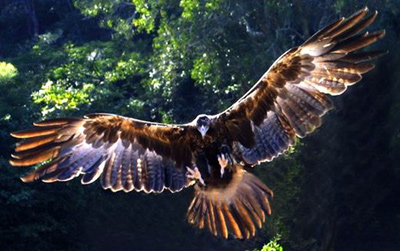|
|
|
|
|
|
|
|
EAGLE
|
Not all eagles migrate. Those that do, have complex migratory patterns. While migrating, eagles ride columns of rising air called thermals and can average speeds of 30 mph (50 kilometers). Effortlessly, an eagle can circle in a strong thermal to a high altitude, then glide long distances in the direction of its migration until it finds the next column of rising air. Generally, the eagles follow seasonal food supplies. As lakes and streams freeze over, bald eagles must go south to find open fresh water or head to the coast.
Adult bald eagles, such as this one, do not migrate with juveniles. Newly fledged eagles migrate before their parents. No one knows how the young birds know when and where to travel.Some fledgling eagles wander in a wide range their first few years. Some return to their origin, while others do not. Only the young eagle knows if this is a conscious decision or if it simply loses its way. |
| |
| Adult bald eagles begin fall migration when the northern lakes and rivers freeze over. Depending on location, they usually migrate to the coast or large rivers near dams, where the water remains open. Wind currents play a large roll in determining their flight pattern.
Some eagles are migratory while others are not. Many eagles in Florida do not migrate, but remain year-round. Most bald eagles migrate south in the fall to areas with sufficient food, and return north in the spring to nest. In the spring, the birds migrate quickly, but during the fall they migrate rather slow. They may remain in an area for a week or so before continuing on. |
| |
| Migrating eagles fly during the day at speeds averaging 30 miles per hour. To help them soar, eagles use thermals, which are rising currents of warm air, and updrafts generated by terrain, such as valley edges or mountain slopes. Soaring is accomplished with very little wing-flapping, enabling them to conserve energy. Long-distance migration flights are accomplished by climbing high in a thermal, then gliding downward to catch the next thermal, where the process is repeated.Bald eagles tend to migrate in groups. A "stream" of migrating bald eagles can be twenty to thirty miles long, with birds spread out about a half mile apart. |
|
|
|
|
|
|
|
| www.baldeagleinfo.com/eagle/eagle10.html |

